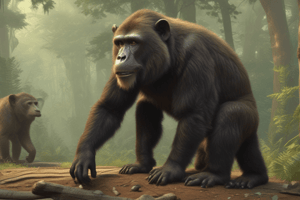Podcast
Questions and Answers
How does the definition of technology evolve based on recent discoveries about tool use in animals?
How does the definition of technology evolve based on recent discoveries about tool use in animals?
Recent discoveries show that some animals, like chimpanzees, can make tools with forethought, suggesting that tool use isn't exclusive to humans.
What role did prehensile hands play in human evolution regarding tool use?
What role did prehensile hands play in human evolution regarding tool use?
Prehensile hands, which evolved alongside the human cortex, allowed better grasp and control of objects crucial for making and using tools.
In what ways did the use of tools enhance the capabilities of Homo sapiens?
In what ways did the use of tools enhance the capabilities of Homo sapiens?
Tools enabled Homo sapiens to capture and domesticate animals, control fire, build shelters, and hunt large game.
What distinguishes the tool-making abilities of humans from those of other animals?
What distinguishes the tool-making abilities of humans from those of other animals?
How did the development of tools influence social life among early humans?
How did the development of tools influence social life among early humans?
How does José Ortega y Gasset describe the role of technology in human evolution?
How does José Ortega y Gasset describe the role of technology in human evolution?
What does the phrase 'invention has been the mother of necessity' imply about human innovation?
What does the phrase 'invention has been the mother of necessity' imply about human innovation?
In what way are tools and machines described as part of larger systems of meaning?
In what way are tools and machines described as part of larger systems of meaning?
What similarities exist between creating a tool and composing a narrative, according to the text?
What similarities exist between creating a tool and composing a narrative, according to the text?
How does the example of a locked automobile illustrate the problem-solving narratives we create?
How does the example of a locked automobile illustrate the problem-solving narratives we create?
Flashcards
Necessity is not the mother of invention
Necessity is not the mother of invention
The act of inventing something first, and then finding a need for it, rather than the other way around.
Tools as meaning-making systems
Tools as meaning-making systems
Machines and tools have deeper meanings than just their practical uses. They reflect our cultural values and how we interact with the world.
Mental projection of a sequence
Mental projection of a sequence
The ability to imagine and plan a sequence of actions, even if they haven't happened yet.
Tools and time
Tools and time
Signup and view all the flashcards
Tools as instruments of control
Tools as instruments of control
Signup and view all the flashcards
Tool Use
Tool Use
Signup and view all the flashcards
Tool Use Impact on Humans
Tool Use Impact on Humans
Signup and view all the flashcards
Homo Erectus and Hand Axes
Homo Erectus and Hand Axes
Signup and view all the flashcards
Human Hand Adaptation for Tool Use
Human Hand Adaptation for Tool Use
Signup and view all the flashcards
Purpose of Technology Beyond Basic Needs
Purpose of Technology Beyond Basic Needs
Signup and view all the flashcards
Study Notes
Defining "Technology"
- One way to define technology is through evolution.
- Animals may use natural objects for a purpose, but humans intentionally create objects for specific functions.
- Early thinkers (e.g., Benjamin Franklin) believed tool use separated humans from other species.
- Recent studies of chimpanzee behavior show tool use by animals, challenging the traditional human-centric view.
- In 2004, scientists discovered a previously unknown species of hominid in Indonesia that used tools.
Tool Use in Chimpanzees
- Jane Goodall observed a chimpanzee using a twig to gather termites as a tool.
- The chimpanzee demonstrated forethought in their tool-making and use.
- This was significant as it indicated tool use by a creature other than humans.
Technology and Human Evolution
- Human tool use reflects complex social life, increased adaptability, and capability.
- Tool use facilitated activities like capturing and domesticating animals, controlling fire, and creating shelter.
- The purpose of technology is not just basic needs, but rather for social evolution, producing things beyond necessary outcomes.
- Technology often precedes the need for it in humans.
- Humans continually redefine their necessities to use tools creatively.
Technology and Narrative
- The meaning of a tool is linked to the stories surrounding it.
- Creating and using a tool is similar to structuring a narrative.
- Tools require mental projection of sequences of actions and outcomes.
- This is vital as it shows technology exists within a wider context, entwined with elements of culture and human experience.
Tools and Knowledge
- Technology is not simply an object, but a combination of objects, skills and knowledge.
- Using a tool is linked to understanding its balance, swing, and sound.
- Tools are understood through physical experiences.
- Cultural context also plays a role in understanding technology through size, shape and use in art and literature.
Chronology of Tool Use
- Tools existed long before writing.
- Different phases of tool use and technology are identifiable, e.g. eotechnic, paleotechnic, and neotechnic.
Technology and Gender
- The development of the concept of "technology" was intertwined with the marginalization of women.
- Women participated in many trades and inventions, in particular, those relating to the production of food and shelter.
- Traditionally, technology has been understood in relation to the masculine.
Studying That Suits You
Use AI to generate personalized quizzes and flashcards to suit your learning preferences.



